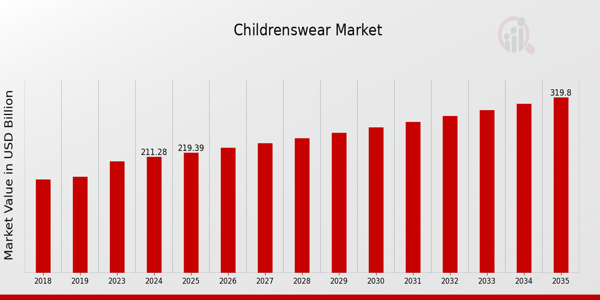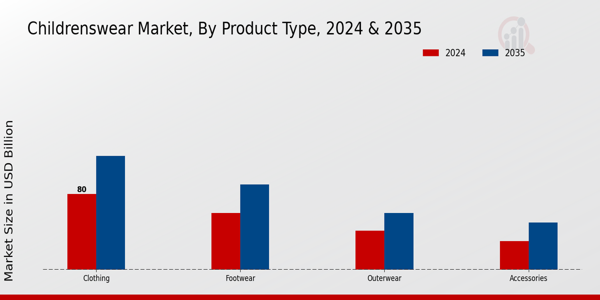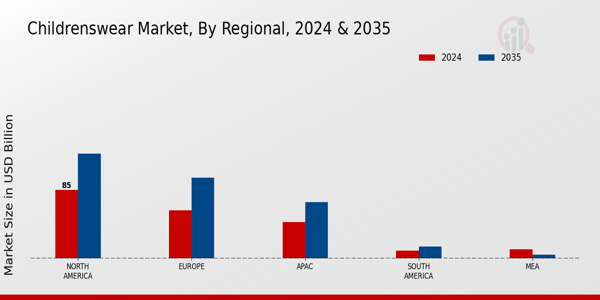Childrenswear Market Overview
Childrenswear Market Size was estimated at 203.47 (USD Billion) in 2023.The Childrenswear Market Industry is expected to grow from 211.28(USD Billion) in 2024 to 320 (USD Billion) by 2035. The Childrenswear Market CAGR (growth rate) is expected to be around 3.84% during the forecast period (2025 - 2035).

Source: Primary Research, Secondary Research, MRFR Database and Analyst Review
Key Childrenswear Market Trends Highlighted
The Global Childrenswear Market is shifting towards sustainable and eco-friendly options. Parents are now more concerned about the environment. The children’s fashion market is further supported by the rising family income and increasing spending on branding, with parents preferring to buy premium labeled clothes which are more fashionable and of better quality. The evolution of online shopping is also a significant factor. The growth of e-commerce has improved access to an unparalleled variety of children’s clothing globally. Moreover, the increasing popularity of personalization offered by many brands through customized clothing tailored to unique individual preferences is emerging.
The rising opportunities for these markets include the addition of new product lines which serve various body shapes, along with the Creation of garments that possess technologies like moisture-wicking capabilities or UV shield features. Additionally, gender-neutral clothing is on the rise and signals that society is moving toward broader inclusivity within fashion. Another recent observation is the increase in endorsements from social media influencers and celebrities for children’s brands, which often helps in increasing engagement and traction for new collections. Also, the COVID-19 pandemic and other global events have emphasized the need for practicality, comfort, and ease, shifting preferences for children’s apparel towards athleisure and casual styles.
This shows that brands must pay attention to consumer trends and social directions alongside continuing to make innovative efforts and improvements.

Source: Primary Research, Secondary Research, MRFR Database and Analyst Review
Childrenswear Market Drivers
Increasing Birth Rates in Global Markets
One of the key drivers for the growth of the Global Childrenswear Market Industry is the rising birth rates observed in various countries. According to the United Nations reports, the global birth rate has been hovering around 18.5 births per 1,000 population as of recent years, particularly in regions like Sub-Saharan Africa where the birth rate is significantly high at approximately 40 births per 1,000 population. This increase in the number of children directly contributes to a larger customer base for childrenswear, leading to increased demand for clothing products suitable for infants and toddlers.Major retailers such as Target Corporation and Walmart have capitalized on this trend by expanding their childrenswear lines, resulting in substantial sales growth. The increase in birth rates ultimately signifies a stable and growing market for manufacturers and retailers of childrenswear, promising a positive outlook for the Global Childrenswear Market Industry in the coming years.
Growing Awareness of Children's Health and Wellness
The rising awareness regarding children's health and wellness has spurred growth in the Global Childrenswear Market Industry. Parents are increasingly prioritizing clothing that promotes safety and comfort, with a shift towards organic and sustainable materials. A survey conducted by the Organic Trade Association indicates that the organic apparel segment has experienced a growth rate of 9.5% annually, as more parents are inclined to choose sustainable options for their children.Brands such as H and Zara are adapting to this trend by integrating organic materials into their childrenswear lines. The emphasis on health and wellness drives parents to invest more in quality clothing, thereby enhancing market potential for the Global Childrenswear Market Industry.
Influence of E-commerce in Children's Fashion
The rapid rise of e-commerce has significantly transformed the Global Childrenswear Market Industry. Statistics show that in 2022, online retail sales accounted for approximately 19% of total global retail sales, a figure forecasted to rise in the coming years. Retail giants like Amazon and specialized online boutiques are tapping into online sales, offering a vast range of childrenswear that cater to diverse consumer preferences. This shift toward digital shopping is particularly advantageous for busy parents looking for convenience and variety.The ability to compare prices and access exclusive deals online further drives purchases, indicating a substantial growth contribution from e-commerce to the Global Childrenswear Market Industry.
Childrenswear Market Segment Insights
Childrenswear Market Product Type Insights
The Global Childrenswear Market is a dynamic and evolving sector that encompasses various product types, including Clothing, Footwear, Accessories, and Outerwear, each contributing significantly to the overall market landscape. The market reached a valuation of 211.28 USD Billion in 2024, this market showcases substantial growth, driven by increasing consumer spending on children's apparel and fashion. The Clothing segment held a majority share, valued at 80.0 USD Billion in 2024, and is projected to grow to 120.0 USD Billion by 2035, reflecting a strong demand for trendy and functional designs.Clothing appeals to parents looking for quality, comfort, and style, underscoring its dominance in the Global Childrenswear Market. Footwear is another critical product type, valued at 60.0 USD Billion in 2024, with an anticipated growth to 90.0 USD Billion by 2035. Footwear offers crucial support for children’s development and daily activities, making it an essential category for parents investing in their children's growth and comfort. The Accessories segment, valued at 30.0 USD Billion in 2024, is projected to grow to 50.0 USD Billion by 2035, highlighting the rising trend of personalized and fashionable items that complement children's outfits, thereby enhancing overall appeal.Lastly, the Outerwear category, valued at 41.28 USD Billion in 2024, is expected to reach 60.0 USD Billion by 2035, driven by seasonal changes and the need for protective clothing, particularly in colder climates. Collectively, these product types reflect a diverse Global Childrenswear Market segmentation approach, characterized by unique consumer demands and trends. As parents continue to emphasize quality, style, and necessity, investing in varied product types fosters growth opportunities across the market, creating a comprehensive offering that caters to the ever-evolving needs of consumers in the global landscape.
Childrenswear Market Age Group Insights
The Global Childrenswear Market, with a projected valuation of 211.28 USD Billion in 2024, shows significant segmentation by Age Group, highlighting the distinct needs and preferences of younger consumers. This market encompasses various age categories including Infants, Toddlers, Preschoolers, and Kids, each representing crucial segments with unique demand drivers. Infants, often characterized by a strong demand for comfort and safety, play a pivotal role in shaping market trends as parents prioritize quality fabrics and sustainable options.Toddlers exhibit a growing preference for vibrant designs and funcational wear, fueling innovation in the market. Preschoolers are increasingly influenced by trends set by media and peers, with brands focusing on playful designs that encourage self-expression, while Kids clothing often emphasizes functionality, style, and adaptability with changing trends. The Global Childrenswear Market statistics reveal that these segments drive substantial growth prospects, aligning with significant spending trends observed in global markets. Overall, the Age Group dynamics contribute to a diversified landscape that influences the Global Childrenswear Market revenue, reflecting both consumer preferences and ongoing market trends.
Childrenswear Market Gender Insights
The Global Childrenswear Market, expected to reach a valuation of 211.28 USD Billion by 2024, showcases a diverse landscape, particularly concerning Gender segmentation, which includes Boys, Girls, and Unisex categories. The demand for Boys' and Girls' apparel continues to be strong, driven by fashion influences and the increasing focus on individual styles from a young age. Unisex clothing is gaining traction as parents seek versatile and gender-neutral options for their children, reflecting broader societal shifts toward inclusivity and versatility in fashion.The predominance of online shopping channels is reshaping the purchasing habits of consumers globally, enhancing convenience and accessibility, which significantly influences market growth. Additionally, the rising awareness surrounding sustainable materials in children's clothing is a noteworthy driver propelling innovation in the Global Childrenswear Market industry. These market dynamics indicate a competitive environment as brands strive to cater to diverse preferences while managing supply chain challenges. Overall, the Global Childrenswear Market exhibits promising potential for growth and transformation, as it adapts to evolving consumer demands and cultural trends.
Childrenswear Market Sales Channel Insights
The Global Childrenswear Market is projected to be valued at 211.28 USD Billion in 2024, showcasing steady growth driven by various sales channels. Among these, online stores have seen a significant surge in popularity, catering to the convenience-focused consumer base. Meanwhile, Brick-and-Mortar stores continue to play a crucial role, offering customers an interactive shopping experience that many still prefer, particularly for children's products where fit and feel are essential. Department stores also contribute to the Global Childrenswear Market, combining multiple brands in one location, providing variety for parents.The market growth reflects changing consumer buying habits, with digital transformation propelling online sales, while physical stores adapt to enhance customer experiences. The rising trend towards sustainability in children's fashion also influences shopping preferences, encouraging both online and offline platforms to incorporate eco-friendly options. The overall market is characterized by a balance between innovation in e-commerce and the enduring appeal of traditional retail spaces, underscoring the importance of diversified sales channels in shaping the future of the industry.
Childrenswear Market Regional Insights
The Global Childrenswear Market, valued at 211.28 USD Billion in 2024, sees significant contributions from various regions. North America leads with a valuation of 85.0 USD Billion, expected to rise to 130.0 USD Billion by 2035, marking it as a major segment due to the high disposable income and consumer spending on children's apparel. Europe was projected to grow from 60.0 USD Billion in 2024 to 100.0 USD Billion in 2035, supported by a strong focus on fashion trends and sustainability in kids' clothing. The Asia-Pacific (APAC) region, with a current valuation of 45.0 USD Billion, is anticipated to reach 70.0 USD Billion, driven by a growing population and increasing urbanization, making it an important market with rapid growth potential.South America and the Middle East and Africa (MEA) represent smaller segments, valued at 10.0 USD Billion and 11.28 USD Billion respectively in 2024. South America's growth is bolstered by rising middle-class income, while MEA's market, though smaller, showcases a unique blend of cultural influences impacting children's fashion trends. Overall, the Global Childrenswear Market segmentation highlights North America's majority holding, while APAC's rapid rise points towards emerging opportunities in the sector driven by demographic shifts and changing consumer preferences.

Source: Primary Research, Secondary Research, MRFR Database and Analyst Review
Childrenswear Market Key Players and Competitive Insights
The Global Childrenswear Market is characterized by a vibrant competitive landscape, heavily influenced by changing consumer preferences, fashion trends, and demographic factors. As parents increasingly seek stylish, durable, and affordable clothing for their children, brands have had to adapt quickly to maintain relevance. This market is defined by a mix of established players and emerging brands, each striving to capture a share of this lucrative segment. Factors such as the growth of e-commerce, the rise of sustainable fashion, and increased spending on children's apparel contribute to the market dynamics. Companies are continually innovating to meet the demands of parents who want functionality coupled with style, creating a competitive environment that shapes product offerings, pricing strategies, and marketing campaigns.Zara has established a formidable presence in the Global Childrenswear Market through its unique business model that emphasizes fast fashion. With a keen eye on current trends and consumer demands, Zara excels in rapidly bringing new designs to market while maintaining a focus on quality. The company leverages its strong supply chain and efficient inventory management to offer a diverse range of children's clothing that appeals to fashion-conscious parents. Zara's strength lies in its ability to adapt its collections seasonally, ensuring relevance and appeal to a broad customer base. This swift responsiveness not only enhances market agility but also fosters brand loyalty among consumers who appreciate on-trend, high-quality apparel for their children.Gymboree, with its rich history in children's fashion, continues to make a notable impact in the Global Childrenswear Market. Known for its stylish and playful clothing, Gymboree offers a variety of key products that cater to both infants and children, including clothing, accessories, and shoes. The brand's focus on quality materials and designs makes it a popular choice among parents looking for fashionable yet practical options. Gymboree has strengthened its market position through strategic mergers and acquisitions, which have expanded its product range and retail presence. This growth strategy, combined with strong branding efforts, solidifies Gymboree's reputation as a trusted name. The company continues to build on its heritage of creativity and fun, ensuring that it remains a relevant player in the highly competitive landscape of global childrenswear.
Key Companies in the Childrenswear Market Include
- Zara
- Gymboree
- Next
- Polo Ralph Lauren
- Carter's
- Baby Gap
- H and M
- Benetton
- Adidas
- OshKosh B'gosch
- Target
- Nike
- Gap
- The Children's Place
- Primark
Childrenswear Market Industry Developments
Recent developments in the Global Childrenswear Market have seen significant fluctuations driven by consumer trends and economic factors. Major players such as Zara, Gymboree, and Nike are navigating challenges posed by supply chain disruptions and changing consumer preferences toward sustainable and eco-friendly apparel. In August 2023, Carter's announced a strategic partnership aimed at enhancing their product offerings while maintaining their commitment to quality and comfort for children. In the realm of mergers and acquisitions, Primark engaged in talks to acquire smaller local brands in various markets to expand its footprint, although no definitive agreement has been reached as of September 2023. The market valuation for Adidas and Gap has shown noticeable growth, with both companies reporting increased year-over-year earnings driven by innovative designs and enhanced marketing strategies. Additionally, the ongoing COVID-19 recovery has led to an uptick in consumer spending on children's fashion, with brands like OshKosh B'gosch and Baby Gap reporting strengthened sales figures during the back-to-school season. Over the past two years, changes in demographics and increased awareness of fashion in social media have also significantly influenced the Global Childrenswear Market's direction.
Childrenswear Market Segmentation Insights
Childrenswear Market Product Type Outlook
- Clothing
- Footwear
- Accessories
- Outerwear
Childrenswear Market Age Group Outlook
- Infants
- Toddlers
- Preschoolers
- Kids
Childrenswear Market Gender Outlook
Childrenswear Market Sales Channel Outlook
- Online Stores
- Brick-and-Mortar Stores
- Department Stores
Childrenswear Market Regional Outlook
- North America
- Europe
- South America
- Asia Pacific
- Middle East and Africa
Report Scope
| Report Attribute/Metric Source: |
Details |
| MARKET SIZE 2023 |
203.47(USD Billion) |
| MARKET SIZE 2024 |
211.28(USD Billion) |
| MARKET SIZE 2035 |
320.0(USD Billion) |
| COMPOUND ANNUAL GROWTH RATE (CAGR) |
3.84% (2025 - 2035) |
| REPORT COVERAGE |
Revenue Forecast, Competitive Landscape, Growth Factors, and Trends |
| BASE YEAR |
2024 |
| MARKET FORECAST PERIOD |
2025 - 2035 |
| HISTORICAL DATA |
2019 - 2024 |
| MARKET FORECAST UNITS |
USD Billion |
| KEY COMPANIES PROFILED |
Zara, Gymboree, Next, Polo Ralph Lauren, Carter's, Baby Gap, H and M, Benetton, Adidas, OshKosh B'gosch, Target, Nike, Gap, The Children's Place, Primark |
| SEGMENTS COVERED |
Product Type, Age Group, Gender, Sales Channel, Regional |
| KEY MARKET OPPORTUNITIES |
Sustainable materials demand, Personalized children's fashion, Growth of online shopping, Increasing disposable incomes, Rise in athleisure trends |
| KEY MARKET DYNAMICS |
increased consumer spending, eco-friendly materials demand, online shopping growth, rising fashion consciousness, seasonal trends impact |
| COUNTRIES COVERED |
North America, Europe, APAC, South America, MEA |
Frequently Asked Questions (FAQ) :
The Global Childrenswear Market is projected to be valued at 211.28 USD Billion in 2024.
By 2035, the market is expected to reach a valuation of 320.0 USD Billion.
The anticipated CAGR for the Global Childrenswear Market from 2025 to 2035 is 3.84%.
North America is expected to have the largest market size, valued at 85.0 USD Billion in 2024.
The footwear segment is anticipated to be valued at 60.0 USD Billion in 2024.
Major players in the market include Zara, Gymboree, Next, Polo Ralph Lauren, and Carter's.
Children's clothing is projected to be valued at 80.0 USD Billion in 2024.
The children's accessories segment is expected to reach a value of 50.0 USD Billion by 2035.
Opportunities in the market are driven by increasing demand for stylish and sustainable childrenswear.
The Asia Pacific region is expected to reach a market size of 70.0 USD Billion by 2035.

















